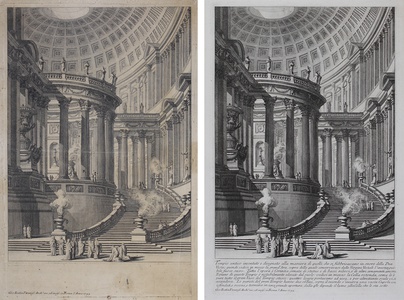| Method | Etching |
| Artist | Giovanni Battista Piranesi |
| Published | Gio. Batta Piranesi Arch.o inv. ed incise in Roma l'Anno 1743 |
| Dimensions | Image 350 x 250 mm, Plate 402 x 260 mm, Sheet 434 x 295 mm [Proof] / Sheet 540 x 420 mm [Published state] |
| Notes |
A proof impression before letters of one of Piranesi's earliest etchings, as well as a separate example of the published state, from a series of architectural caprices that were initially issued in his first published work, Prima Parte di Architetture, e Prospettive inventate, ed incise da Gio. Batta Piranesi Architetto Veneziano dedicate al Sig. Nicola Giobbe. The book was intended by Piranesi to challenge what he perceived as the languid nature of contemporary Roman architecture when compared to the grandeur of the antique past. The plates owe much to Baroque theatre design as well as the many capricci painted by his near contemporaries, but already display Piranesi's deep understanding and appreciation of classical forms and the romantic effect of time on antique stone. The book as published in 1743 contained 12 plates, and was evidently not successful, as there were no further parts despite the title's suggestion of further additions. In 1750, the plates, along with a set of five others engraved in the intervening years, were published in Bouchard's Opere Varie, along with some grotesques, a further two capricci, and the plates of the Carceri d'invenzione. The current example is one of the five additional plates engraved in the years between the publication of the Prima Parte and the Opera Varie, and one of only two to carry a definite date of 1743, suggesting that Piranesi may have begun preparing them in anticipation of a second volume. The new plates all featured large descriptive texts below, a schema that was retrospectively applied to later printings of the original 12 plates. As the description shows, this plate was intended to represent a building inspired by the circular temples of Vesta, goddess of the hearth and home, like the famous examples in the Roman Forum and Tivoli that would later occupy Piranesi in his Vedute. The circular portico surrounding the altar, upon which the sacred flame billows smoke, is here surrounded by a circular precinct wall, with a vaulted dome and oculus clearly replicating the interior of the Pantheon. The scale of the building is truly monumental, with figures in the guise of togate worshippers dotted throughout the scene to emphasise the sheer scale of the stairs and colonnades. With the exception of a date and attribution in the bottom left, the large inscription space in this proof is empty, though light scratched lining and some illegible text immediately below the border of the image can still be seen. The full text of the published version reads: Tempio antico inventato e disegnato alla maniera di quelli che si fabbricavano in onore della Dea Vesta; quindi vedesi in mezzo la grand'Ara, sopra della quale conservavasi dalle Vergini Vestali l'inestinguibile fuoco sacro. Tutta l'opera e Corintia ornata di statue e di bassi rilievi, e di altri ornamenti ancora Il piano di questo Tempio e notabilmente elevato dal suolo: vedesi in mezzo la Cella rotonda, come lo e pure tutto il gran Vaso, del Tempio stesso: quattro loggie portavano ad essa, e per altrettante scale vi si ascendeva. Le parieti del gran Tempio hanno due ordini, sopra il secondo s'incurva una vasta Cupola con isfondati, e rosoni, e termina in una grande apertura, dalla quale dipende il lume alla Cella che le sta sotto. Giovanni Battista (also Giambattista) Piranesi (1720 – 1778) was an Italian artist famous for his etchings of Rome and of fictitious and atmospheric "prisons" (the Carceri d'Invenzione). He was a major Italian printmaker, architect and antiquarian. The son of a Venetian master builder, he studied architecture and stage design, through which he became familiar with Illusionism. During the 1740's, when Rome was emerging as the centre of Neoclassicism, Piranesi began his lifelong obsession with the city's architecture. He was taught to etch by Giuseppe Vasi and this became the medium for which he was best known. Wilton Ely 17, F17, C339a, R19 (Proof) Condition: Proof: Time toned, soiled, and creased. Puntures and chips to platemark and edges of sheet, particularly corners. Old repaired tear to right margin, with associated discolouration. Published state: Crisp clean impression with full margins. Minor time toning, creasing, and small tears to edges of sheet. Large oilstain to top left of sheet, not affecting image or plate. |
| Framing | unmounted |
| Price | £2,000.00 |
| Stock ID | 51313 |

